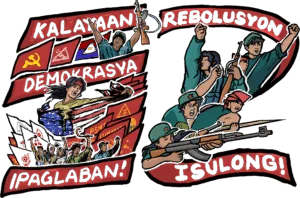4. People's Wars in Southeast Asia, 1960 to 1975
The communist and noncommunist forces in the armed struggle against the US-supported Ngo Din Diem regime united to form the South Vietnam National Liberation Front in 1960. In 1961 the US began to deploy large numbers of "advisors" in the South Vietnamese military and bureaucracy and in 1964 it began to launch military operations against the Democratic Republic of Vietnam by land, sea and air.
The US war of aggression against the people of Vietnam became indubitably clear with the rapid deployment of hundreds of thousands of US troops and with large military operations from US military bases inside and outside of Vietnam. The Vietnamese communists and people were determined to carry out a war of national liberation against the US war of aggression through the strategy of protracted people's war.
At that time, the Vietnam Workers Party was close to the Communist Party of China under Comrade Mao Zedong. It was disappointed that the Communist Party of the Soviet Union under Khrushchov was hyping the general line of peaceful coexistence and the road of peaceful transition and was not interested in assisting the Vietnamese communists in people's war. It was only after the overthrow of Khrushchov that the Communist Party of the Soviet Union under Brezhnev extended support to the Vietnamese war of national liberation. Consequently, the Vietnam Workers' Party took a centrist position in the Sino-Soviet ideological debate.
The US escalated its military intervention through military advisors and military supplies to the level of a full-scale war of aggression involving hundreds of thousands of troops, huge US military bases and US fire bases all over South Vietnam. It engaged in all types of vicious military campaigns in South Vietnam and made frequent bombing raids on North Vietnam. The Vietnamese people intensified their resistance and inflicted heavy casualties on US and puppet troops on the ground, shot down thousands of US planes and destroyed convoys of enemy vehicles.
The US instigated the military coup in Cambodia against Sihanouk by Lon Nol in 1970 in the vain hope of disrupting and preventing the passage of supplies for the South Vietnam National Liberation Front through either the so-called Ho Chi Minh trail or ports of Cambodia. Earlier in 1968 the Communist Party of Kampuchea had launched the armed revolution against the Sihanouk government. But the overthrow of Sihanouk by Lon Nol brought about the conditions for the alliance between the Communist Party of Kampuchea and the forces of Sihanouk with the support of the Communist Party of China.
The people's war led by the Communist Party of Cambodia advanced very rapidly. The alliance of patriotic forces formed the Royal Government of National Union of Kampuchea. The Vietnamese, Kampuchean and Laotian revolutionary parties and peoples united in waging people's war against US imperialism and its puppet forces. Their intensified people's wars compelled the US to negotiate towards the Paris Peace Accord of 1973 and paved the way for the total victories of their revolutionary struggle for national liberation against US imperialism
From 1960 onward, the calls for people's war in Southeast Asia resounded against the continuing aggressiveness of the US in expanding its hegemony. In the growing Sino-Soviet ideological debate the revisionist line of Khrushchov did not dull but sharpened the resolve of the communist parties to wage armed revolution. The Great Proletarian Cultural Revolution in China further sharpened such resolve and the Communist Party of China under the leadership of Chairman Mao was enthusiastic in supporting the communist parties that decided to wage people's war in Indochina, Thailand, Burma, Malaya, Kalimantan Utara and the Philippines. All these had long been inspired by the victories of the Chinese people in the new democratic and socialist revolutions and in making a great breach on the imperialist front in the East.
Even the Communist Party of Indonesia, which had become the biggest communist party among those in nonsocialist states by pursuing the line of peaceful and legal struggle from 1951 to 1965, began from 1963 onwards to consider the necessity of armed revolution against armed counterrevolution. It was then categorically expressing support for the Marxiist-Leninist line of the Chinese Communist Party in the ideological debate against the line of modern revisionism espoused by the Communist Party of the Soviet Union headed by Khrushchov. But it also wanted to retain friendly relations with the Soviet party.
It intended to "prepare" for the armed struggle by waging the campaign of rural investigation and intensified peasant organizing, the campaign to nationalize foreign enterprises and the "crush Malaysia" campaign. It called on the Sukarno government for arming the people, especially the militia. But it remained unclear on whether to wage armed struggle against the semi-colonial state and was vacillating about what form of armed revolution it would undertake, even as the US, British and Dutch imperialists and their puppets headed by Suharto were feverishly preparing to massacre the Indonesian communists, their mass following and sympathizers in 1965-66.
The debacle of the Indonesian communists was in sharp contrast to the growing victories and ultimate victory of the Indochinese communists against US imperialism in the period of 1965 to 1975. But the communists of Indonesia were still expected to fight back and recover their debacle through people's war. However, they did not succeed in their initial efforts at people's war in Blitar and Kalimantan in 1967 and 1968. Their further defeat allowed the US, British, Dutch and Japanese imperialists to take advantage of the oil and other natural resources of Indonesia. The North Kalimantan Communist Party was founded only in 1971 and had some armed units. It was unable to sustain and develop its revolutionary armed struggle.
Since 1961, the Communist Party of Thailand had taken a strong Marxist-Leninist position in the Sino-Soviet ideological debate and decided to adopt the strategic line of protracted people's war. It started guerrilla warfare in 1965 in the northeastern provinces of Thailand along the border with Laos, where they won the support of the Meo tribesmen, and subsequently spread to the northern provinces and to the extreme south, where the Malayan Communist Party and people's army were based. The Thai People's Liberation Army received considerable support after 1970 from China and the Democratic Republic of Vietnam. It was able to carry out major offensives, including raids on US air force bomber bases in Thailand.
In the early 1960s the Burmese Communist Party also took a strong Marxist-Leninist position in the Sino-Soviet ideological debate. In 1967 the Communist Party of China openly declared its support for the Burmese communists and their people's war. The Burmese Communist Party transferred its headquarters to the Chinese border area and received substantial military assistance from China. However, in 1967-68, it mishandled a rectification movement and committed grave errors which undermined the revolutionary integrity, strength and prestige of the party in the short and long term.
As early as 1959 the proletarian revolutionaries in the Philippines were already desirous of resuming the armed revolution along the general line of the people's democratic revolution through protracted people's war. They were also enlightened by the international debate between the Marxist-Leninists and modern revisionists in the early 1960s and inspired by the Great Proletarian Cultural Revolution from 1966 onwards. But they were also desirous of summing up and analyzing the concrete conditions and revolutionary experience in the Philippines, rectifying errors and rebuilding the revolutionary party of the proletariat and the anti-imperialist and anti-feudal mass movement for a certain period of time before launching the people's war.
The rectification movement under the guidance of Marxism-Leninism-Mao Zedong Thought began in 1967. The Communist Party of the Philippines was reestablished on December 26, 1968 and in a few months' time founded the New People's Army on March 29, 1969. The enemy tried to nip the armed revolutionary movement in the bud from 1969 to 1971, pitting a full division against a few squads of the NPA, but failed. Then in 1972 the Marcos regime began to impose a fourteen-year fascist dictatorship on the Filipino people. The revolutionary forces and people grew even stronger through people's war.
The period of 1960 to 1975 may be described as the period when the whole of Southeast Asia was the focus of the storm of the world proletarian revolution through people's war and the eye of the storm was in Vietnam and then the whole of Indochina, when the people's war completely triumphed in 1975. In view of this great victory, there were bright hopes for the peoples of Thailand, Burma, Malaya, Indonesia and the Philippines to persevere in people's war and win their own great victories.

